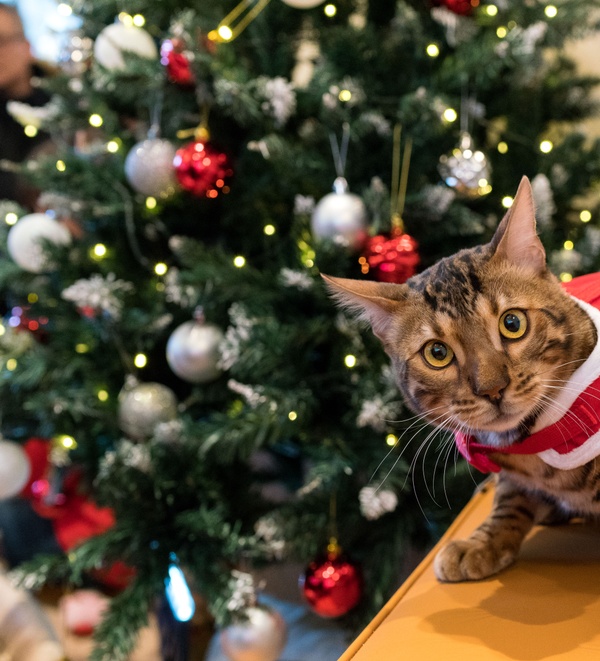
Pet-Friendly Holiday Decorating Tips
If you plan to deck out your home in holiday decor, go for it! But, make sure to plan ahead so your beautiful displays are not only festive, but also pet-proof.
Confidently decorate your home with the below pet safety tips in mind.
1. String Lights and Electric Cords
Indoor and outdoor lights can really brighten up the home with holiday cheer, but electric lights may also attract the attention of curious pets. Risks include electric shocks or burns from lights or cords, or possibly a pet becoming dangerously entangled.
Prevent hazards by keeping cords and lights out of reach. Place them high up where dogs and cats can’t access them (avoiding the lowest branches of your Christmas tree), and consider adding protective cord covers if needed.
2. Ornaments, Displays, & Small Objects
Glass ornaments and other items can be very sharp if they break or if a pet bites them. And, ingestion of small objects, like festive figurines, can cause an intestinal obstruction, which requires surgery to remove the object.
Avoid this by keeping the lower branches of your Christmas tree free of ornaments, especially breakable ones or plush ones where the stuffing could be swallowed. And, keep other displays (like mangers, train sets, etc.) on high shelves that pets can’t reach.
SEE ALSO: Hosting the Holidays With Your Pet In Mind
3. Tinsel
Tinsel and ribbons may be beautiful, but ingestion of these string-like decorations can cause an intestinal blockage that requires surgery. Usually, ingestion happens accidentally during the course of playing with these strings, and is much more common in cats than in dogs.
Fortunately, you can prevent this issue by not using tinsel at all, and by keeping other strings out of your pet’s reach. Playtime with ribbon is fine so long as it’s supervised.
SEE ALSO: 7 Holiday Foods to Avoid Feeding Your Pet
4. Candles
Whether you’re lighting a menorah or you just enjoy the ambience of glowing candles, it’s important to keep candle safety in mind. Playful pets may walk too close to candles or knock them over, resulting in burns or even in accidental fires.
To prevent this, keep candles out of reach, and blow them out when you’re not in the room. Alternatively, consider using flameless candles.
5. Christmas Trees
Though typical Christmas trees (spruce, fir, and pine) are not poisonous to dogs and cats, they can present several other hazards:
- Oils from needles and branches can cause mouth and stomach irritation, resulting in drooling, vomiting, and diarrhea.
- Sharp, non-digestible needles can puncture the mouth or digestive tract, or even cause an intestinal obstruction if ingested in large amounts.
- Tree water can contain toxins. It often accumulates fertilizers, bacteria, and toxic tree preservatives — all of which are harmful if your dog or cat drinks the Christmas tree water.
- Cats notoriously knock trees over since they like to climb, and rambunctious pups can also test your tree’s stability.
Even though holiday trees may pose some risks, if you follow the below precautions you and your loved ones can still safely enjoy the tree:
- Use a sturdy holder or anchor.
- Block access to tree water.
- Place your tree in a room with a door that closes, so your cat or dog and the Christmas tree are separated unless there’s supervision. A playpen or other barrier might also work—just double check that your agile pet can’t jump over it.
- Consider using an artificial tree.
- Whether you have a real tree or an artificial one, prevent your pet from breaking off and eating pieces of the tree.
Get more tips about avoiding Christmas tree-related mishaps here.
6. Holiday Plants
While often considered to be highly toxic, poinsettias are fairly safe for pets. However, they may cause digestive upset if eaten.
Holly can also cause nausea and vomiting, and symptoms are usually more severe than they would be for poinsettias.
Mistletoe can also cause stomach upset, along with more serious effects like an abnormal heart rate, collapse, seizures, and even death if ingested in large amounts.
Also, lilies can cause kidney failure in cats. ALL parts of the plant are dangerous, including any pollen, leaves, or petals that fall to the floor.
For all of these reasons, it’s best to avoid decorating with plants — especially lilies and mistletoe.
If you must decorate with live plants, keep them well out of reach of curious pets: Place them high up and on a wide shelf, so that falling leaves and petals collect on the shelf rather than falling to the floor.
When in doubt, look up a plant — and whether it’s safe for pets — before bringing it into your home. Here’s a very helpful resource from the ASPCA Animal Poison Control Center.
Learn more about poisonous plants for dogs here and for cats here.
So, what should you do if you suspect your pet is sick from a toxic plant or ingesting a holiday decoration?
Have numbers available for the Pet Poison Helpline or ASPCA Animal Poison Control Center. Helpful experts on these lines will listen as you describe what your pet ate and how much. Then, they can either let you know it’s not a big deal, or they can tell you what symptoms to watch for and whether you should seek veterinary care.
As long as you avoid decorating your home with potentially pet-dangerous items, you and your furry BFF safely enjoy a festive home.
A festive home doesn’t have to come at the expense of your pet’s safety. By following these tips, you can create a beautiful, hazard-free space for the holidays. Have questions about specific decorations or concerns about your pet’s safety? Bond Vet is here to help. Schedule a visit or reach out to us anytime for expert guidance—we’re dedicated to your pet’s health and happiness!
SEE ALSO: Holiday Safety Tips for Pet Parents